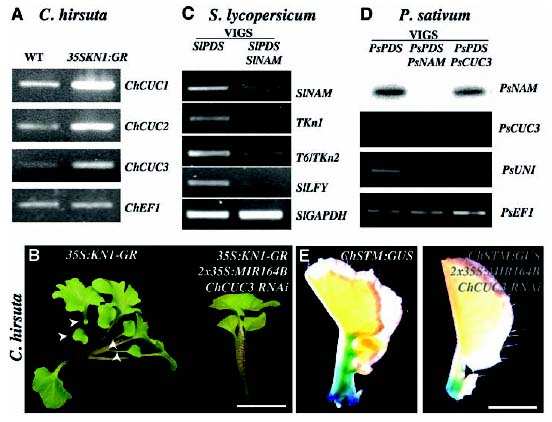博文
Science: 发现负责复叶形成的基因(转载)
|||
今天上午看到实验室一位老师阅读的一篇文献,觉得很有意思,贴在这里共享。
(转载自:生物谷Bioon.com):植物的叶子即可以是一个简单的叶片,也可以由多个单独的小叶组成。此外,无论单叶还是复叶都可能具有齿状或圆突状的边缘。法国国家农业研究所和牛津大学的科学家找到了负责双子叶植物叶片形成的基因家族。
研究人员重点研究了NAM/CUC3基因家族,当叶子从茎上生长时,这类基因使叶子的边界区域出现分离。科学家们研究了这些基因在耧斗菜、西红柿、碎米芥和豌豆等具有小叶的一类远亲植物中的表达情况。他们发现,这些基因在嫩叶周围的边界区域中表达,并且这种表达要先于叶子出现。利用具有NAM/CUC3缺陷表达的突变体,研究人员证明了这类基因家族的重要性。没有这些基因,叶子生长就会出现反常,锯齿状边缘消失,小叶长在一起,并且叶子数目减少。
A Conserved Molecular Framework for Compound Leaf Development
Thomas Blein, et al. , Science 322, 1835 (2008);
DOI: 10.1126/science.1166168
http://www.sciencemag.org/cgi/reprint/322/5909/1835.pdf
文章就不贴了,自己去看。通过下面几个图就知道大致意思了!
图一:
Fig. 1. Leaf shape and expression of the NAM/CUC3 genes during leaf development in eudicots: A. caerulea [(A) to (D)], S. lycopersicum [(E) to (H)], S. tuberosum [(I) to (L)], C. hirsuta [(M) to (Q)], and P. sativum [(R) to (U)]. (A) A. caerulea leaf formed by three leaflets subdivided into three majors lobes (arrow), each of which is dissected (arrowhead). (B and C) In a young leaf primordium, AcNAM and AcCUC3 are expressed in relation to the formation of the leaflet primordial (arrows). AcNAM expression is restricted to the distal side of the primordium marked in (B) by an asterisk. (D) AcNAM expression is coincident with further leaflet primordia (ltp) dissection (arrowhead). (E) S. lycopersicum leaf formed by primary (I), secondary (II), and intercalary (Int) leaflets that have dissected margins. (F and G) SlNAM expression precedes leaflet outgrowth [arrow in (F)] and marks the distal boundary of young or older leaflet primordial (asterisks). (H) SlNAM is expressed in relation with the serration of older leaflet (lt) margins (arrowheads). (I) S. tuberosum leaf formed by primary leaflets with entire leaf margins. (J to L) StNAM and StCUC3 are expressed during early stages of leaflet initiation (J) and are still detected at later stages [(K) and (L)]. Asterisk in (K) indicates a young leaflet primordium showing StNAM expression only on its distal part. (M) A rosette leaf of C. hirsute formed by several leaflets that show mild incision of their margins. (NtoQ) ChCUC1, ChCUC2, and ChCUC3 are expressed during leaflet initiation and at later stages. ChCUC expression is limited to the distal part of young [asterisk in (N)] and older [asterisks in (Q)] primordia. (R) P. sativum leaf formed by several pairs of proximal leaflets (lt) and distal tendrils (tdl). Leafletlike stipules (st) subtend the leaf. (S to U) The PsNAM1/2 and PsCUC3 genes are expressed during leaflet and tendril primordia development. PsNAM1/2 is expressed in the distal boundary of young [asterisk in (S)] and older [asterisks in (T)] leaflet primordia. Scale bars indicate
图二:

Fig. 2. Reducing NAM/CUC3 activity leads to a simplification of compound leaves. (A) Successive leaves formedon an A. caerulea plant silenced for the AcPDS, AcNAM, and AcCUC3 genes. Note the progressive smoothening of the leaflet margins from leaf 1 to 3 (arrowheads). At the final stage (leaf 4), corresponding to early silencing, a simple leaf with an entire margin is formed. (B) Control leaf of P. sativum silenced for PsPDS with three pairs of leaflets and three pairs of tendrils subtended by a pair of stipules (st). (C) P. sativum leaf silenced for PsPDS, PsNAM1/2, and PsCUC3 formed by one pair of leaflets and one pair of tendrils separated by a long, organless rachis (arrow). (D) P. sativum leaf silenced for PsPDS, PsNAM1/2, and PsCUC3 showing fusions between leaflets (left arrow) and between a leaflet and the rachis (right arrow). (E) Control leaf of S. lycopersicum silenced for SlPDS showing primary (I), secondary (II), and intercalary (Int) leaflets. (F) S. lycopersicum leaf silenced for SlPDS and SlNAM showing smoothed leaf margins (arrowhead), fusions between leaflets (arrow), and fewer leaflets. (G) Leaf of gob3 that harbors amutation in the SlNAM gene and is similar to a SlNAM-silenced leaf. (H) Rosette leaf number 8 of wild-type (WT) C. hirsuta and of a line with reduced CUC expression (2x35S:MIR164b ChCUC3 RNAi). A reduced number of leaflets leads to a long, leafletless petiole and the fusion of the leaflets (arrows). (I) First cauline leaf of WT C. hirsute and of a plant silenced for ChCUC3 showing fewer and smoothed leaflets (arrowhead). Scale bars,
图三:

Fig. 3. Interplay between the NAM/CUC3 genes and other regulators of compound leaf development. (A) After 2 days of induction of the KN1: GR fusion, the expression of ChCUC1, ChCUC2, and ChCUC3 was increased compared with that of WT C. hirsuta control plants. ChEF1 was used as an internal control. (B) Upon dexamethasone induction, ectopic leaflets were formed on the primary leaflets in C. hirsute expressing a KN1-GR fusion (arrowheads). No ectopic leaflets were formed when the same construct is induced in a background with reduced ChCUC activity (2x35S:MIR164B ChCUC3 RNAi). (C) A reduction of SlNAM expression after SlPDS SlNAM VIGS was correlated with reduced expression of SlLFY and of the two KNOXI genes TKn1 and T6/TKn2. SlGAPDH was used as an internal control. (D) PsNAM1/2 and PsCUC3 expression was reduced in plants silenced for PsPDS PsNAM1/2 or PsPDS PsCUC3, respectively, and correlated with lower UNI expression. PsEF1 was used as an internal control. (E) The ChSTM: GUS reporter was expressed in the petiole and rachis of a WT C. hirsuta leaf, and its expression was strongly reduced in a background with reduced ChCUC activity (2x35S:MIR164B ChCUC3 RNAi). Scale bars,
https://wap.sciencenet.cn/blog-204736-227231.html
上一篇:带你看火山口的壮丽景观(我的山东之行)
下一篇:行道树之王“法国梧桐”将会不“飞毛”